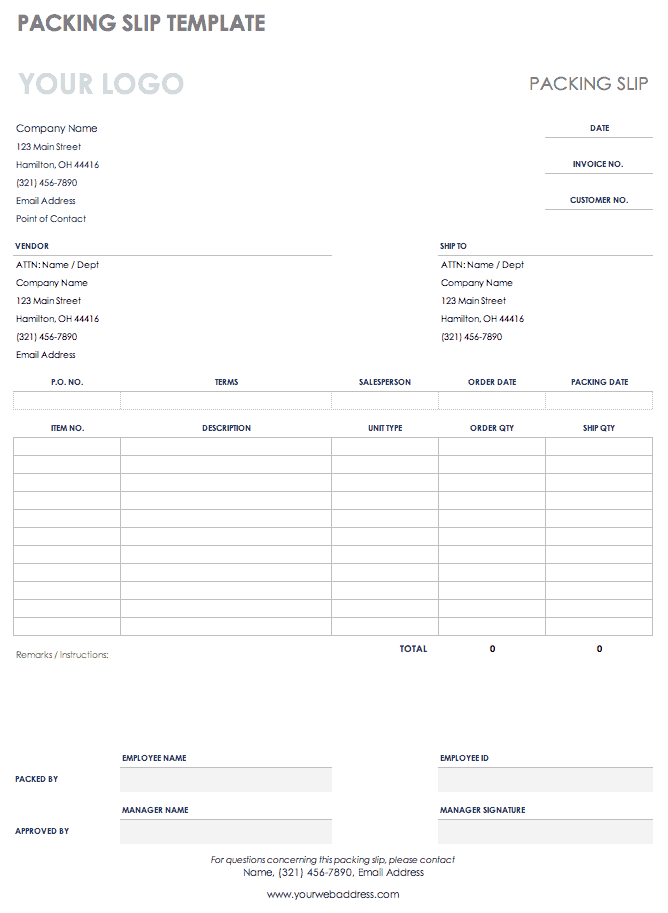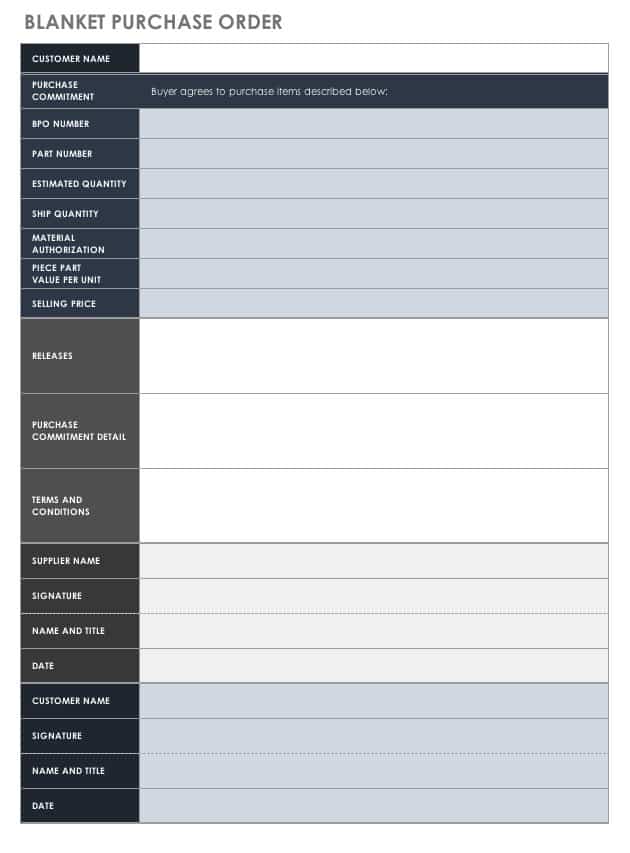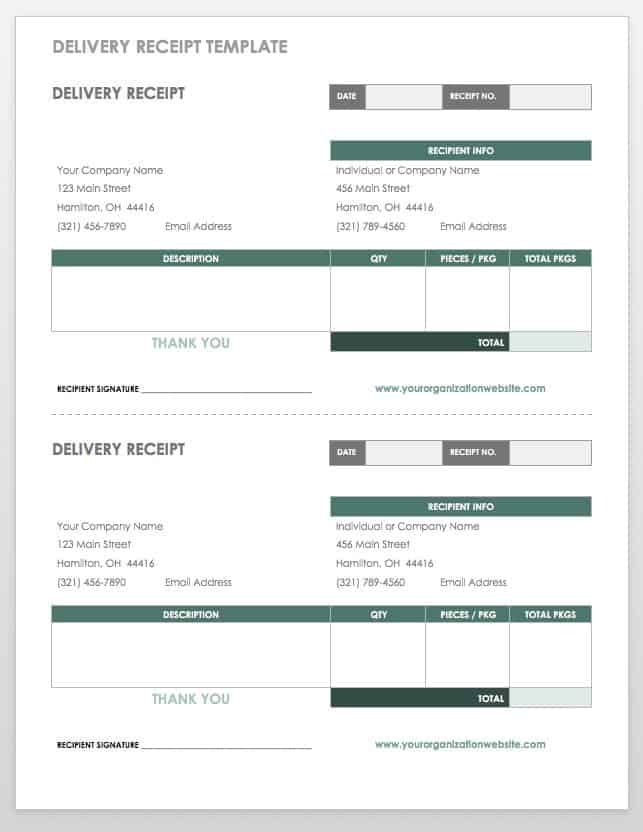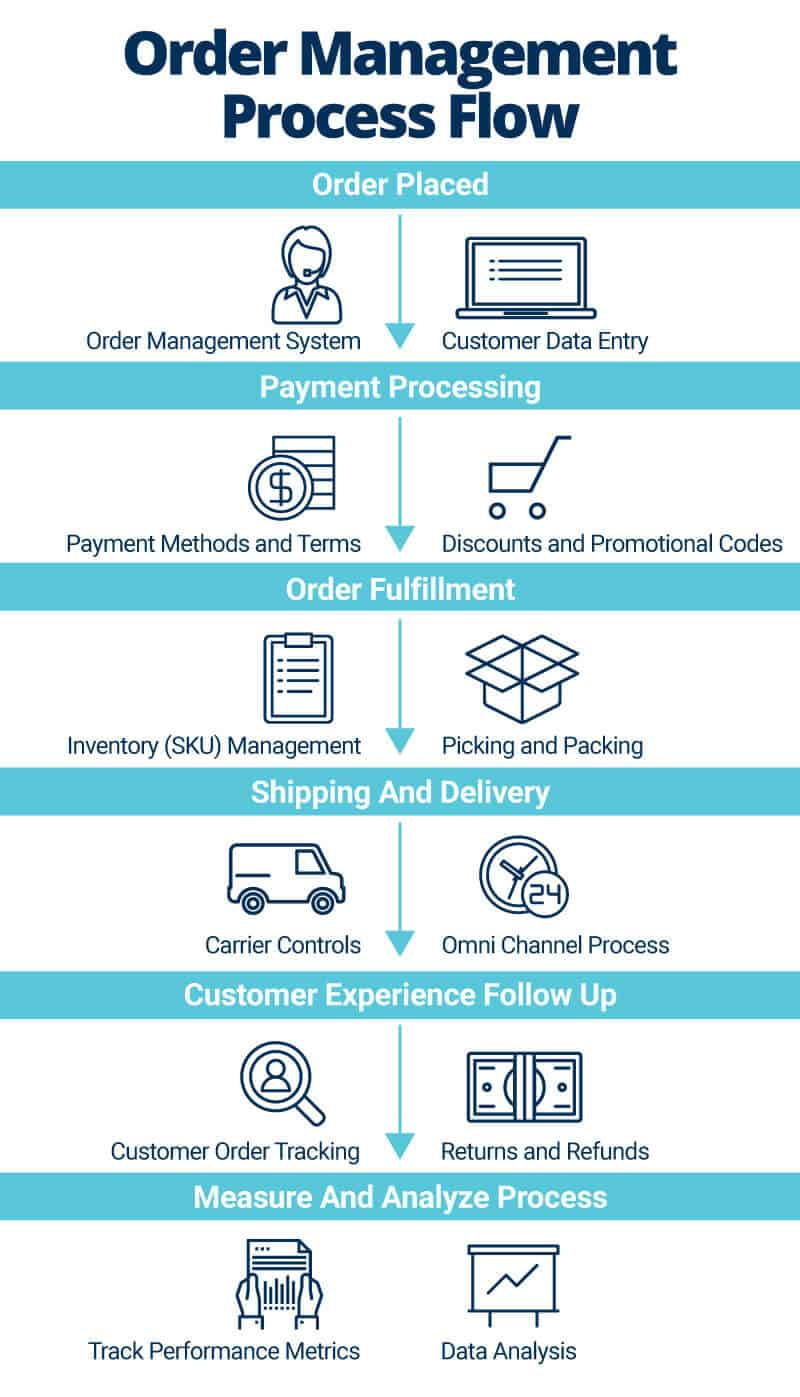What Is Customer Order Management?
Customer order management (COM) refers to the business processes and services involved in ordering goods and services — purchasing, processing, fulfilling, shipping, delivering, and following up with the customer. COM systems are information systems that are integrated on a network with enterprise resource planning (ERP) systems or order management systems (OMS). A COM system provides direct order data, like pricing, discount, markup standards, and product availability to internal business services and to the customer.
Like OMS, integrated customer order systems are flexible enough to manage order-to-cash (O2C) and purchase-to-pay back office accounting services, like online payment processing, accounts payable/receivable billing, and inventory management. These systems price items from a wide array of discount and markup rules. For more information about the order management process and OMS, read “The Essential Guide to Order Management.”
The Benefits of Customer Order History Management
The goal of customer order management (and the technology behind the process) is to deliver customer orders in a profitable, reproducible, and trackable manner. COM functions as a component of a coordinated supply chain, where the distributed order fulfillment process meets sales, marketing, and customer service strategies. Analyzing the data recorded and organized in modern COM systems provides real-time insights into product profitability and supply chain performance metrics. Your ability to track and analyze metrics such as fulfillment rates and customer service statistics (like response time) relies on accurate, up-to-date customer history data.
Recording and analyzing customer order history is an essential function of customer relationship management (CRM). COM software includes service portals that integrate CRM databases with order fulfillment functions to track order history metrics. These online portals provide customer service representatives (CSRs) with access to real-time order history metrics (for example, order backlogs) that are displayed on a dashboard arranged by customer. The purpose of tracking customer order history data is to combine customer experience strategies with order fulfillment details and supply chain metrics in order to strengthen customer relations.
Customer Order Management Features
COM software captures complex order history data in one shot, without the need for manual entry intervention or reporting. And, the software performs this task more accurately than a staff member would by tracking data in Microsoft Excel. This capability provides real-time insights into customer order history, like the status of an order in the fulfillment cycle. Automated document management features integrate with large ERP systems to merge customer order history data with back office general ledger accounting. This capability offers precise control over data in order to help manage product and service profit margins or customer credit terms.
In addition to furnishing advanced order history data analysis, COM software provides web-based modules (software applications) that have features to manage the following business capabilities:
-
Mobile Customers: Mobile software applications allow suppliers and customers to check inventory availability, track order status remotely, manage delivery details, and print picking, packing, shipping, and delivery documents on wireless devices.
-
Document Management: COM applications automate customer order documentation with web-modules in order to create quotations, issue credit memos, create purchase orders (POs), and manage call-off orders or blanket PO (a PO with multiple delivery dates over a period of time) invoices. The software removes manual steps, like creating and recording warehouse documents (such as inventory pick tickets and packing lists) by sending automated email notifications with electronic PO order documentation, thereby minimizing time and material waste and eliminating the need for faxing and archiving physical documents.
-
Direct Fulfillment: Amazon Launchpad defines a direct fulfillment vendor as a company that ships individual goods from a U.S. warehouse directly to a customer when Amazon does not stock the desired product. Automated inventory management is a COM strategy that ensures no sales are missed and that customers continuously order products in a real-time, reactive supply chain.
-
Shipping Schedules: Web-based COM software provides shipping features capable of managing third-party carriers, finding blanket order rates on high-value products, and managing international shipping schedules and customs. These features eliminate the need for separate shipping applications and accounts.
-
Product Configuration: COM software provides content management capabilities that facilitate configuring changes to product packaging, pack size, freight dimensions, or product descriptions across different databases and e-commerce applications.
Packing Slip Template
A shipment includes a packing slip and a sales invoice. A packing slip lists the items a customer ordered along with the items that actually shipped. Delivery is a critical stage in the COM process as well as the customer experience. This free packing slip template allows customers to quickly see any discrepancies in their order and verify that the order is fulfilled as expected. Consider using COM software with automated document management capabilities to improve inventory management and planning and reduce the chance of data-entry errors.
Download Packing Slip Template
Excel
| Smartsheet
Blanket Purchase Order Template
A blanket purchase order (PO) is an agreement between two parties for multiple deliveries over a set time frame. Use this template to manage your customer order history and add your own price terms, as well as include order information and authorization signatures. If special pricing is part of the deal you’re conducting, add the order details, terms, and conditions of the blanket PO purchase agreement.
Download Blanket Purchase Order Template
Careers in Customer Order Management
Customer order management careers are competitive and challenging. They require a variety of skills and responsibilities that merge the traditional processes and activities of the supply chain with customer service in the digital economy. Customer order management professionals engage in business activities such as inventory allocation, purchasing, sales order management, account-based marketing, warehouse management, and marketing activities (e.g., advertising, promotions, and market research).
A job description for a customer order specialist might list responsibilities and desired qualities like the following:
-
Must have strong business acumen
-
Must be able to communicate order and inventory status using EDI, COM web portals, and e-mail
-
Must be able to make product sales
-
Must coordinate warehouse logistics and return and refund processing
-
Must conduct customer experience follow-up surveys
Backgrounds in fields such as supply chain management, customer service, human resources, information technology, data and analytics, sales and marketing, and hospitality are well represented.
The search term “customer order management” yields a list of 150,000 COM-related jobs on the job site indeed.com, including the following:
-
Customer service equipment management
-
Customer order management specialist
-
Customer service order entry specialist
-
Electronic data interchange (EDI) specialist
-
Order processing and sales support specialist
-
Order process management supervisor
-
Order processing coordinator
-
Customer order management representative
-
Customer order management specialist
-
Customer order fraud specialist
-
Customer champion
How to Improve Customer Order Management and the Customer Service Experience
Creating value for your customers is at the core of your business services and operational design. If your decision making is customer-centric, you meet customer demand better than the competition. Order management is a function of a coordinated supply chain; in the digital economy of the information age, supply chain processes and technology integrate with customer service performance.
Customer order management is order fulfillment in collaboration with customer service activities. To survive and thrive, you must organize every action in an integrated supply chain — purchasing, producing, distributing, fulfilling, shipping, and delivering products — around the customer experience. Better, faster, and cheaper COM strategies enable a profitable supply chain.
“Giving the customer quick access to their order status, along with the ability to make changes if needed, will greatly enhance the customer experience and reduce the amount of status update calls that the members of the order entry team receive. This approach will substantially improve the job experiences of order entry staff, because they will spend less time entering orders and dealing with irate customers and more time on value-add tasks that can also improve the customer experience,” says Smith.
Smith believes that leveraging automated COM technology can indirectly provide a customer experience strategy that spurs growth: “Your order entry team can make better use of their time by focusing more on improving your customer experience. Doing so is proven to help companies grow their business. Your employees will enjoy their jobs more, an attitude which carries over to your customers as well.”
The Fundamentals Of Effective Customer Order Management Performance
Understand what the customer wants, make or purchase the product package, ship the product, track the delivery to completion, and follow up with the customer — an effective customer order management process and technology supports these steps to adds value to the customer experience. The fundamentals of COM are rooted in order fulfillment logistics and the supply chain activity they support. These fundamentals include the following elements:
-
Customer Demand: The COM system you leverage is capable of making your supply chain more efficient — the amount of improvement is dependent on the type of COM process and the type of data it receives. Within your COM system, communicating customer order requirements accurately and consistently is a key element of efficient order fulfillment. This communication process starts with the sales and customer service employees responsible for order processing and extends to the logistics managers accountable for verifying that the company fulfills the order correctly and meets customer preference for shipping and delivery.
-
Integrate Channels: Integrate your COM system with all of your order channels to provide (and meet) realistic order promises that you make to your customers. Your COM software needs to communicate the same real-time inventory availability and pricing to customers shopping online as well as to your sales reps in the field. Consolidate your order channels by selecting COM software that integrates with your existing inventory management system, or consider a COM system that acts as an end-to-end platform integration for your entire order management process. To reduce order entry mistakes that lead to lost sales and inaccurate inventory, use cloud-based COM software that automatically tracks orders against real-time inventory availability and syncs data, including order pricing and specifications, with mobile applications.
-
Surrender Delivery: The goal is to get the product to the customer, and how that happens might be in the hands of the customer. Empowering the customer with the ability to control delivery assignments (for example, by type of carrier and shipping schedule) gives them access to customization, a popular method for enhancing the customer experience. Delivery customization is a value-added marketing and logistics service that Amazon made famous with its online ordering process. Amazon customers embrace this feature because the company’s software automatically weaves their information into the order process; customers know that to finalize their online order, they choose from a list of custom delivery methods.
-
Acknowledge Orders: COM software provides tracking information throughout the order management process lifecycle via both internal and external automated notifications. Today’s customer expects a high degree of visibility into their orders. One way to increase this level of visibility for the customer is to add a post-delivery fulfillment acknowledgment of the customer order. Using a COM system with CRM capabilities, you can perform the following tasks: track data on customer order history, send an automatic 30-day follow-up email, make product recommendations based on a previous purchase, and ask for participation in customer service surveys to track important COM metrics.
Delivery Receipt Template
Use this free template to manage customer orders and verify that a shipment has been delivered. The template includes space to add inventory items, customer and supplier contact information, and a recipient signature. Add your company logo or additional details to customize a receipt.
What Is Customer Order Processing?
Customer order processing refers to the sequential activities involved in order fulfillment, from order entry to product delivery. This process lives within the supply chain management ecosystem. The fundamental business services that make up order processing concern the following supply chain practices:
-
Order placement and data entry
-
Payment processing
-
Order fulfillment
-
Inventory and warehouse management
-
Picking and packing
-
Shipping and delivery
-
Carrier control
-
Customer order tracking
-
Returns and refunds
Customer Order Process Workflow
Software developers use the customer order process sequence of supply chain and customer service activities (or tasks) to build distributed COM applications that mimic and enhance the process. Doing so ensures that the COM application will notify everyone involved in the workflow at the appropriate time and that it will activate the next order fulfillment step in the proper sequence.
Amazon Web Services (AWS) defines a workflow as a mechanism to execute a number of distributed application tasks asynchronously. Amazon Simple Workflow Service (SWF) is a workflow management service in AWS. Using the customer order processing workflow as an example, developers can build distributed COM software applications that manage multiple order processing activities asynchronously. These apps can also handle processing activities with multiple computing resources, such as inventory management systems and accounting software, as “sequential and parallel as needed.” The customer order processing workflow of this COM software would include the following workflow steps:
-
A customer places an online order.
-
The application verifies the order in a separate environment.
-
Once the app verifies the order, the payment processing application charges the customer.
-
After the payment is processed, the warehouse receives the order and picks, packages, and ships the order.
-
The software records the workflow history in a database and the workflow ends with a successful delivery event.
The data that the customer order processing workflow generates and the information that the COM software records in a database are helpful in determining performance metrics. You use these metrics to audit your COM process and assess its impact on customer experience. Managing and analyzing this data is a valuable component of an effective COM strategy.
Customer Order Metrics: The New Customer Voice
The information age, spawned by the internet and wireless networks and the growth of e-commerce, has increased customer demand for quick, responsive order capabilities. However, the use of fragmented software that lacks integration across all COM process activities makes it difficult to access the valuable customer service information that empowers this accelerated responsiveness. Subsequently, the dearth of accurate, real-time information and COM systems and processes that help manage this data makes it challenging to control the order processing workflow. Challenges with managing internal workflows lead to customer service problems and poor customer experience.
Implementing COM systems that exchange real-time data is the first step in managing customer orders. The ability to share information in the form of key performance indicators (KPIs) provides a different perspective on how your supply chain impacts the customer experience, thus, giving a new voice to COM problems. COM systems designed with segmented channel management capabilities offer metrics to track performance and profitability by product, brand, pack size, channel website, and customer segment.
The new trend is to monitor and analyze metrics that show how customer order management processes (merged with marketing and order fulfillment data) encourage better customer service strategies. Such customer service strategies include order responsiveness and inventory quality management. And, these metrics include data such as the order fill rate, order lead time, order processing cycle time, customer returns and capability-to-promise (CTP), available-to-promise (ATP), and profitable-to-promise (PTP) processes.
COM vendors now offer customer support automation and CRM capabilities to help manage customer issues (like message-based online customer support queries) through digital channels. Technology trends like automated business intelligence and supervised machine learning provide a glance at the future capabilities of COM systems. Soon, COM systems will be able to generate customer service-related metrics that provide strategies beyond those related to internal manufacturing or supply chain performance KPIs:
-
Artificial Intelligence: Using advanced machine learning, the COM system improves the ability of your supply chain operations to deliver customer requirements, maintain the infrastructure required to fulfill orders, and provide data to align customer demand with inventory management. Computers may have the power to read a customer complaint message or request for help, generate an accurate, automated response, and send the customer a message that addresses the issue and provides the appropriate steps to return inventory and receive a refund.
-
Sentiment Analytics: Using data generated by supervised machine learning algorithms, future COM systems will share information regarding the following: what customers think about a new software update, the reviews customers create, and keyword optimization for digital advertising. This data will evolve over time to empower cost-saving customer service strategies. Automation and machine learning AI will eliminate the need for a customer to contact customer service via phone in order to address order status problems. The system will learn about repetitive order processing problems, inventory shortages, or delivery delays based on data fed to advanced neural networks and will predict the appropriate response.
Customer Order Metrics and Effective Order Management Process from the Pros
“Do they want to analyze what’s selling vs. what’s not selling vs. what’s on backorder? Do they want to analyze how they’re receiving orders? If they’re integrated with an e-commerce system, do they want to know what’s in stock? All of these questions can help companies get more efficient and grow,” says Pave. “The key is to know your company’s (order) process from the minute the order is placed to the minute the order is delivered.”
Pave identifies data collection and the use of supply chain metrics as popular trends in his business: “People are using more and more data to get better and make predictions. What’s coming out of their system? What do they need to order more of? What items do people like? What categorical trends are taking place? Companies that can pick up trends right before they blow up and be ready for them are the ones dominating the marketplace,” he concludes.
The data analytics ethos of garbage in/garbage out applies to COM system data. These systems need accurate product information, standardized sales channels, and order entry configuration to generate useful metrics. For manufacturers, COM metrics provide access to data that highlights incomplete planning and production processes. Order processing data generated by integrated COM systems communicating with ERP databases provides demand forecasting metrics and business intelligence that empower cost-saving strategies like aggregate order processing and lean manufacturing methods.
Customer Order Tracking Solutions for Improving Customer Experiences
In the context of the digital economy, the customer order tracking capability shifts the balance of power from internal priorities to customer expectations. Wireless networks, mobile applications, and the computing power of smartphones give customers more choices for following order status and an amplified voice (i.e., social networks) when order problems surface. Your order tracking process — and the technology you choose to manage it — is essential to selecting COM software or integrating an end-to-end COM platform.
“The detailed requirements for customer order management vary depending on the nature of the business,” says Altemir. “(We) focus on manufacturing. For manufacture-to-order and engineer-to-order businesses, we look for ERP systems where the customer order can be used to capture the customer’s desired delivery date and provide a regularly updated estimated completion date (ECD) on a line-item-by-line-item basis.”
Altemir prefers systems that allow customer orders to organize and track different order statuses in searchable categorizes, such as “new” or “pending.”
“The ability to characterize the customer order (as new or pending) allows the company to perform a formal customer order review acceptance process (that) enables advanced tracking, so the customer knows where each order stands,” says Altemir. “This is an important and sometimes overlooked process because it ensures that only feasible orders are accepted and, in so doing, enables the manufacturer to reliably make decisions. Unfortunately, many systems do not have these features, so it is crucial to know what you’re looking for when selecting an order management system,” he emphasizes.
According to Altemir, existing systems can be customized at the database or reporting level to augment existing systems and provide this missing functionality. “For manufacturers, the customer order is the thing that drives manufacturing and material requirements at the top level,” he says.
“It’s also typically accessible to customer-facing employees that need to be able to report on the progress of open orders. For these two reasons — customization and accessibility — the ability to maintain two separate dates for each customer order line item is useful because one date (initially set at the time of order entry) drives demand, whereas the other date captures feedback from the shop floor to assess the up-to-date schedule health of each order,” Altemir points out.
B2B Customer Order Status Tracking and Customer Experience
Managing the customer's ordering is at the core of ERP systems. From order processing and fulfillment activity to material management (manufacturing), account billing, and cash flow, the flow of orders — from inventory to customer — must integrate with all the systems involved in managing and fulfilling customer orders. COM software vendors and large ERP platform providers develop their order management applications to serve as a single source of information to manage and analyze customer order processing workflow tasks and data.
The ability to track order status is as important to B2B suppliers as it is to B2C customer satisfaction. Customers want insight into where the order is at every stage, and the customer order tracking applications designed for B2B systems provide customers with answers to tracking-related questions by using automated workflow notifications. These tracking apps share information about the order fulfillment stage, missing inventory tracking, warehouse location tracking, delivery status, and shipping notifications. Rather than providing partial order fulfillment visibility, the best COM tracking applications are holistic, accounting for every line item of a purchase order. Order tracking software that merges customer service and supply chain functions provides a customer with the following functions:
-
Integrated order tracking notification with internal information systems or customer-facing, web-based applications (for example, a WordPress e-commerce website)
-
Automated order confirmation and status notification email templates with opt-in, opt-out, and data privacy notices
-
Order status categories that are searchable by a tracking number that has shipping carrier API integrations (that is, back-end tracking systems provided by UPS and FedEx that link via email to the order status tracking page of the carrier’s website)
-
Supplier system integration for spreadsheet-based orders
-
For sales reps, customer service notes management with custom fields and styling options for exporting data
Customer Order Status and the Bottom Line
Simply put, if you don’t match the needs and expectations of your customers, they will buy from another business or supplier that delivers the product with the anticipated value. Some of the most advanced levels of major retail operations, such as Walmart and Amazon, use COM process and order management technology that places the demands of the customer and supplier at the forefront of supply chain operations. By focusing on value-add logistics and COM processes, these retail behemoths influence when a product is available for purchase and where it is located in proximity to the customer.
Customer service matters to every logistics manager, supply chain specialist, and warehouse robot, too. The efficiency of an automated Amazon warehouse robot moving product around a warehouse at all hours of the day or the data a supplier receives regarding an out-of-stock product when they’re searching Walmart’s Retail Link application is passed on to the customer’s experience by the value added in these services. In these examples, apps reduce the time it takes to process, ship, and deliver a customer order — as well as make sure it’s available in the first place. The efficiency of COM software applications also extends to the direct communication involved in managing customer order status.
“You don’t want to play telephone and have multiple people touching an order each time,” says Pave. “You want to get your customer what they want in the most efficient way possible. If you can set up your order system so that it automates as much as possible and eliminates double data entry and any risks for human error, you will be set up for success: shorter delivery times, higher customer satisfaction, higher rate-of-repeat orders, and more frequent orders.
“Employee satisfaction also plays a part in the bottom line,” says Pave. “Turnover is expensive. If employees spend less time on busy work, they have more time for high-value work. They become happier, more empowered, and more productive, which will increase employee satisfaction and lower the employee turnover rate,” he concludes.
Build Powerful, Automated Customer Order Management Processes with Smartsheet
Empower your people to go above and beyond with a flexible platform designed to match the needs of your team — and adapt as those needs change.
The Smartsheet platform makes it easy to plan, capture, manage, and report on work from anywhere, helping your team be more effective and get more done. Report on key metrics and get real-time visibility into work as it happens with roll-up reports, dashboards, and automated workflows built to keep your team connected and informed.
When teams have clarity into the work getting done, there’s no telling how much more they can accomplish in the same amount of time. Try Smartsheet for free, today.






